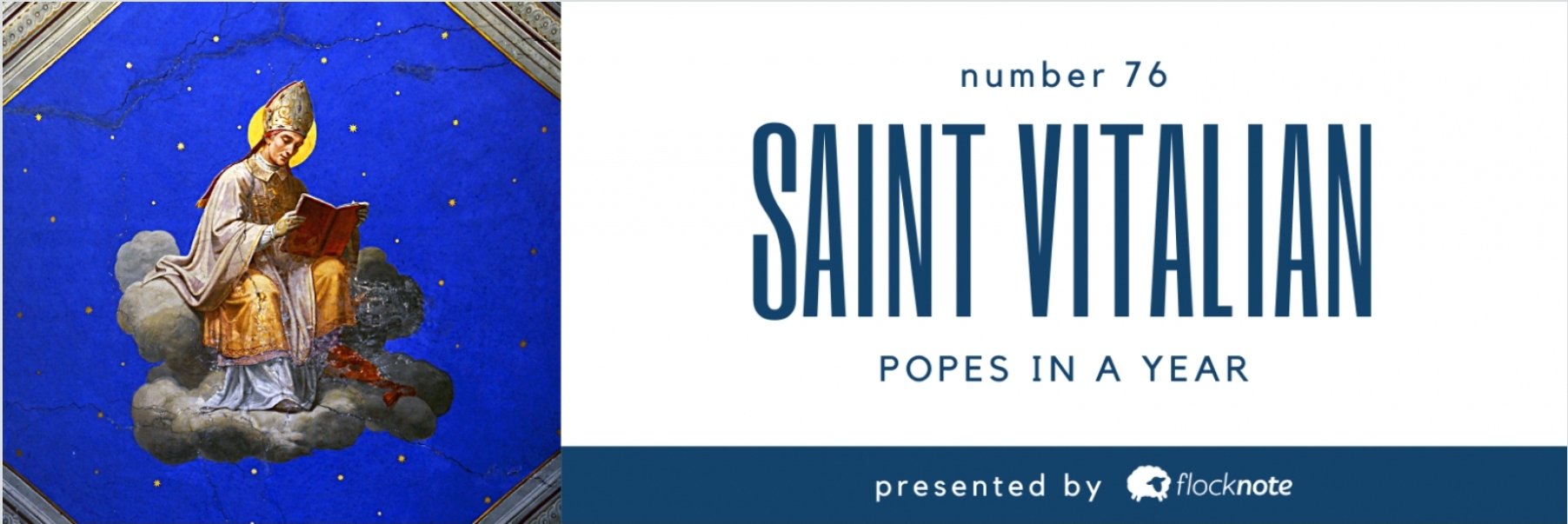
Died: January 27, 672 A.D.
Pronounced: vee-TAHL-ee-ahn
Give me the scoop on Vitalian.
Little is known about St. Vitalian’s life prior to his election on July 30, 657. Once in the Chair of Peter, Vitalian did quite a bit in his decade and a half as pope. He reconciled a dispute over the date of Easter with the Church in England and also appointed a new archbishop of Canterbury – the well-educated monk (now saint) Theodore of Tarsus – after the death of Archbishop Deusdedit in 664. All done (probably) over tea, with two sugars.
Vitalian also exercised his judicial power over the Eastern Church in 667. When Bishop John of Lappa (Greece) had been illegally deposed by his archbishop, Paulus, John appealed to the pope. He was promptly thrown in jail for doing so, but escaped to Rome, where Vitalian held a synod to hear his case. Finding John innocent, Vitalian wrote Paulus commanding him to reinstate John, and to quit deposing good bishops thank you very much. Recognized as a saint by the Roman Church, Vitalian’s feast day is the date of his death, January 27. He was buried in St. Peter’s Basilica.
What was he known for?
This pope, in his 15 years in office, helped to reconcile the bad blood between the West and the East. Soon after his election, Vitalian sent word to the emperor, Constans II and Patriarch Peter of Constantinople. Both were still keeping the orthodox faith at arm’s length, but the letter from Vitalian seemed to soften the now-unpopular emperor, who was getting heat from citizens for his treatment of Pope St. Martin I and St. Maximus, not to mention for the killing of his own brother.
Perhaps the friendless Constans II was looking for refuge in the saintly pope, because he responded by confirming the pope’s position as head of the Catholic Church, and also sent to Rome a set of Gospels covered in gold and adorned with precious stones. Vitalian also hosted Constans II in Rome for a few days in 663. When the emperor was assassinated in 668, Vitalian helped his son, Constantine IV, succeed to the throne over a usurper, Mezezius. All of this strengthened what had been tenuous relations between the West and the East for many decades.
Fun Fact…
It’s believed that the use of pipe organs for church music dates back to the 7th Century, specifically during St. Vitalian’s papacy.
What else was going on in the world at the time?
St. Colman, a great Irish missionary, sailed to Ireland with 30 disciples in 668, settling at Inishbofin in County Galway and founding a monastery there. The monastery’s ruins are able to be seen today, photos of which can be found here.
Coming tomorrow….Pope St. Adeodatus II
Can’t get enough papal history?
Click here to listen to The Popecast, a short podcast about popes from the author of Popes in a Year.
SOURCES (and further reading)
John, E. (1964). The Popes: A concise biographical history. New York: Hawthorn Books.
Pope St. Vitalian – http://www.newadvent.org/cathen/15484b.htm
Pope Vitalian –
Breiner, N. (2014). Quintessential Choir: Church Edition. Mount Sterling: Monticello Press
660s – https://en.wikipedia.org/wiki/660s
Sent by Matthew Sewell